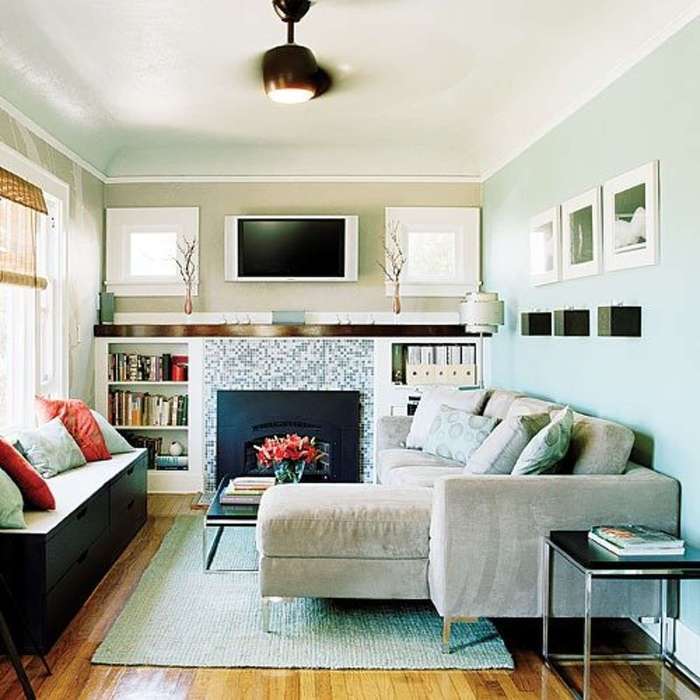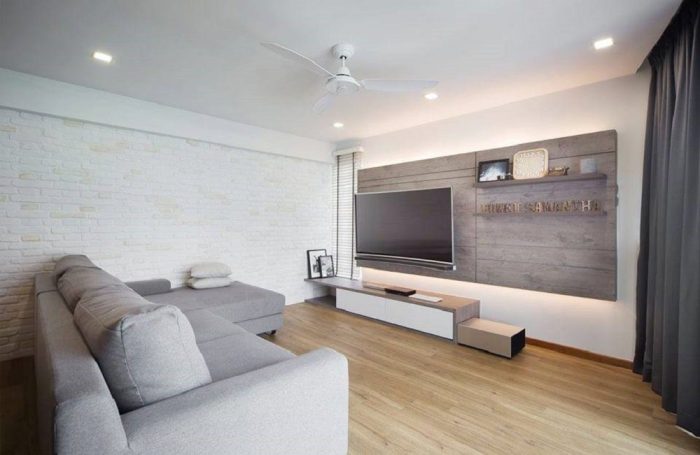Space Optimization Techniques
Maximizing small spaces requires a thoughtful approach to furniture arrangement and design elements. By strategically placing furniture and utilizing multifunctional pieces, you can create a more spacious and organized environment.
Clever Furniture Arrangement
Arranging furniture in a small space can greatly influence its functionality. Here are some techniques to consider:
- Use floating furniture layouts that create walkways and open up the room.
- Position larger pieces against the walls to free up central areas.
- Incorporate corner sofas to make use of underutilized areas.
Multifunctional Furniture
Opting for furniture that serves multiple purposes can save precious square footage. Examples include:
- Storage ottomans that can serve as seating and storage solutions.
- Murphy beds that fold into the wall, transforming a bedroom into a functional workspace.
- Convertible coffee tables that expand for meals or work.
Vertical Space Usage
Utilizing vertical space is crucial in small homes. Consider the following storage solutions:
- Wall-mounted shelves that add storage without taking up floor space.
- Over-the-door organizers for shoes or miscellaneous items.
- Hanging plants that add greenery without consuming shelf space.
Color Schemes and Aesthetics
Choosing the right color palette can significantly impact how large a space feels. Lighter colors can create an illusion of openness and brightness, while thoughtful lighting enhances those effects.
Color Palettes for Illusion
Incorporating specific color schemes can help make small spaces feel larger:
- Soft whites and pastel shades reflect light, creating a more airy atmosphere.
- Monochromatic schemes offer a cohesive look, minimizing visual clutter.
- Accent colors can be introduced through decor items to add interest without overwhelming the space.
Lighting Influences
The right lighting can dramatically influence how we perceive space. Here are effective lighting tips:
- Use layered lighting with ambient, task, and accent lights for depth.
- Incorporate natural light where possible by using sheer curtains.
- Install LED strips under cabinets or shelves to illuminate dark corners.
Reflective Surfaces
Mirrors and reflective surfaces can enhance brightness and depth:
- Large mirrors can double the visual space of a room.
- Reflective furniture or decor can bounce light around, creating an illusion of more space.
- Decorative mirrors can also serve as art pieces, adding character to the decor.
Small Kitchen Renovation Tips
Kitchens can often feel cramped in small homes. However, with the right design elements, you can optimize the layout and functionality without sacrificing style.
Optimizing Kitchen Layouts
An efficient kitchen layout is essential for maximizing functionality:
- Consider the work triangle concept, ensuring that the stove, sink, and refrigerator are easily accessible.
- Implement a galley kitchen design to conserve space while maintaining workflow efficiency.
- Install countertops that extend to provide additional prep space.
Compact Appliances
Selecting the right appliances is crucial in small kitchens. Look for:
- Appliances that are specifically designed for small spaces, such as slim refrigerators and compact dishwashers.
- Multi-cookers that can replace several kitchen gadgets with one device.
- Stackable washers and dryers that save space in laundry areas.
Maximizing Kitchen Storage
To prevent clutter in small kitchens, consider these storage solutions:
- Pull-out shelves and drawers in cabinets for easy access to items.
- Magnetic strips for knives or spices that free up counter space.
- Vertical storage racks for pots and pans to keep them organized and accessible.
Bathroom Design Innovations
Bathrooms present unique challenges in small homes, but innovative design can turn them into functional and stylish spaces.
Space-Saving Fixtures
Choosing the right fixtures can significantly enhance a tiny bathroom:
- Wall-mounted sinks and toilets free up floor space.
- Shower stalls instead of bathtubs to maximize available area.
- Sliding barn doors can save space compared to traditional swinging doors.
Wall-Mounted Installations

Utilizing wall-mounted installations provides numerous benefits:
- Creating a sense of openness by keeping the floor clear.
- Easy cleaning underneath fixtures for a tidy appearance.
- Offering additional storage options above installations for toiletries or decor.
Natural and Artificial Lighting
Incorporating lighting effectively can transform a small bathroom:
- Frosted windows allow natural light while maintaining privacy.
- Recessed lighting to eliminate shadows and brighten the space.
- LED light strips around mirrors to enhance functionality while adding ambiance.
Creative Use of Outdoor Spaces
Outdoor areas can serve as extensions of your home, even when limited in size. With some creativity, balconies and small yards can become functional retreats.
Transforming Balconies and Yards
Designing outdoor spaces for usability can enhance your living area:
- Utilize furniture designed for small spaces, such as folding chairs and tables.
- Incorporate outdoor rugs to define areas and add comfort.
- Install rail planters to maximize greenery without sacrificing space.
Vertical Gardens and Container Gardening
For those with limited ground space, vertical and container gardening are excellent options:
- Vertical planters can maximize wall space for herbs and flowers.
- Hanging baskets can add color and life without taking up floor space.
- Portable containers allow for flexible gardening arrangements based on sun exposure.
Cozy Seating Areas
Even in limited spaces, cozy seating can be achieved:
- Use built-in benches or daybeds along walls for lounging.
- Incorporate cushions and throws for added comfort and style.
- Create intimate settings with outdoor lighting like string lights or lanterns.
DIY Renovation Projects
Embarking on DIY renovations can be a rewarding way to enhance your small home. With the right approach, these projects can be accomplished in a weekend.
Simple DIY Project Steps
Here are straightforward DIY projects that elevate small home designs:
- Painting walls to refresh the space and create a new atmosphere.
- Building floating shelves for added storage and display.
- Creating a feature wall using removable wallpaper or decals.
Tools and Materials
Having the right tools and materials is essential for successful DIY projects:
- A basic tool kit including a hammer, screwdriver, level, and measuring tape.
- Paint rollers and brushes for wall projects.
- Wood or brackets for shelf installation.
Budget-Friendly DIY Ideas
For those on a budget, consider these affordable renovation ideas:
- Repurposing old furniture with a fresh coat of paint or new hardware.
- Creating artwork with inexpensive materials for personalization.
- Installing peel-and-stick tiles for an updated look without heavy investment.
Sustainable Design Choices
Incorporating sustainable practices and materials not only benefits the environment but also enhances the quality of life in small homes.
Eco-Friendly Materials
Utilizing eco-friendly materials is crucial in small home renovations:
- Reclaimed wood for flooring or furniture can add character while reducing waste.
- Low-VOC paints and finishes ensure better indoor air quality.
- Natural stone surfaces provide durability and sustainability.
Sustainable Practices
Implementing sustainable practices can be simpler than you think:
- Opting for energy-efficient appliances that consume less power.
- Using rainwater collection systems for outdoor watering.
- Incorporating solar panels to reduce energy costs over time.
Energy-Efficient Upgrades
Upgrading to energy-efficient solutions can significantly benefit small spaces:
- Installing double-glazed windows to improve insulation.
- Using programmable thermostats to optimize heating and cooling.
- Choosing LED lighting options for lower energy consumption.
Trends in Small Home Renovations
Staying updated with trends can empower homeowners to make informed choices in their renovations.
Emerging Design Trends
Several emerging trends are shaping small home design:
- Minimalist aesthetics focus on simplicity and functionality.
- Biophilic design integrates nature into living spaces for improved well-being.
- Smart home technology enhances comfort and efficiency in small environments.
Popular Styles for Compact Living
Certain styles work particularly well in small spaces:
- Scandinavian design emphasizes light colors and multifunctional furniture.
- Industrial style uses raw materials, creating an open and airy feel.
- Modern farmhouse blends rustic charm with contemporary appeal.
Technology Integration
Modern small home renovations often include tech integration:
- Smart appliances that optimize space and functionality.
- Home automation systems for enhanced control over lighting and climate.
- Wireless charging stations built into furniture for convenience.

